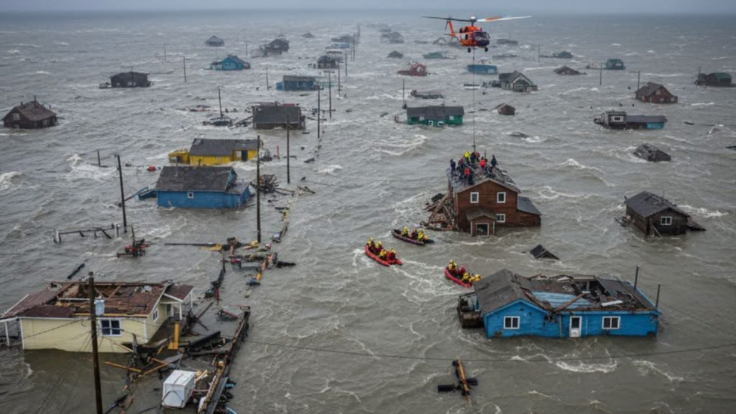Alaska's Kipnuk Evacuated by Air as Typhoon-Related Flooding Swamps Coastal Villages

Amid one of Alaska's largest civilian airlifts ever, helicopters and military C-17s are evacuating residents from Kipnuk and Kwigillingok after the remnants of Typhoon Halong unleashed a record storm surge of more than 6 feet, sweeping away homes and leaving entire villages underwater.
The flooding struck overnight, giving families little time to escape. Authorities confirm at least one fatality and two missing, while hundreds are displaced and infrastructure lies in ruins.
In interviews with local radio, community leaders described scenes of panic as floodwaters rose rapidly overnight, forcing families onto rooftops with little more than the clothes they were wearing. Many residents left behind cherished belongings and traditional hunting gear that form the backbone of daily survival.
Evacuation In Force, Infrastructure in Shambles
Officials say the crisis prompted an emergency airlift operation to move villagers first to Bethel, then onward to Anchorage, utilising military transport aircraft.
Local shelters in Bethel soon filled, forcing some evacuees to be flown directly to Anchorage's Alaska Airlines Centre.
In Kipnuk alone, authorities report 121 homes were destroyed, and every structure sustained damage.
By Wednesday, evacuees were being flown from Bethel (a regional hub) to Anchorage on C-17 military transports after shelters in Bethel hit capacity. Many evacuees had first sheltered in local schools, where conditions were crowded and straining.
Coastal villages like Kipnuk and Kwigillingok are reachable only by air or water. Roads are few, and many residents rely on boardwalks, small planes or boats for transport. Once floodwaters recede, rebuilding will be slow, especially as winter approaches and supply routes become more constrained.
Horror On The Ground: Homes Floating, Families Fleeing
Survivors recount that floodwaters rose quickly, forcing many to seek refuge on rooftops. In some cases, entire houses drifted away—some even while still occupied.
One Kipnuk resident said, 'It didn't look real'—describing the surreal sight of homes floating freely.
Utilities, boardwalks and runways were submerged or damaged, cutting off ground access to these remote Alaska Native communities.
The Bigger Picture: Vulnerability, Climate, and Policy
The storm surge exceeded 6.6 feet above mean high water in Kipnuk, a record in the region.
Many analysts link the storm's intensity to warming ocean temperatures and shifting weather patterns in the Pacific.
Critics note that federal cuts to climate resilience programmes left communities underprepared. A $20 million EPA grant aimed at erosion control and infrastructure in Kipnuk had been cancelled before the disaster.
What Comes Next: Recovery, Rebuild, Return
Winter is approaching quickly, adding urgency to the response. Many houses are now uninhabitable, and rebuilding will depend on air or barge-delivered materials.
Priority now is ensuring shelter, food, medicine and heat for evacuees. Authorities have warned residents not to reenter damaged homes before safety assessments.
In the long term, communities face the choice of returning to flood-prone land or relocating. The disaster revived debates on federal investment, climate adaptation and infrastructure in Indigenous Alaska.
The immediate priority, however, is shelter, food, medical care and protective support as temperatures drop and winter nears.
© Copyright IBTimes 2025. All rights reserved.





















